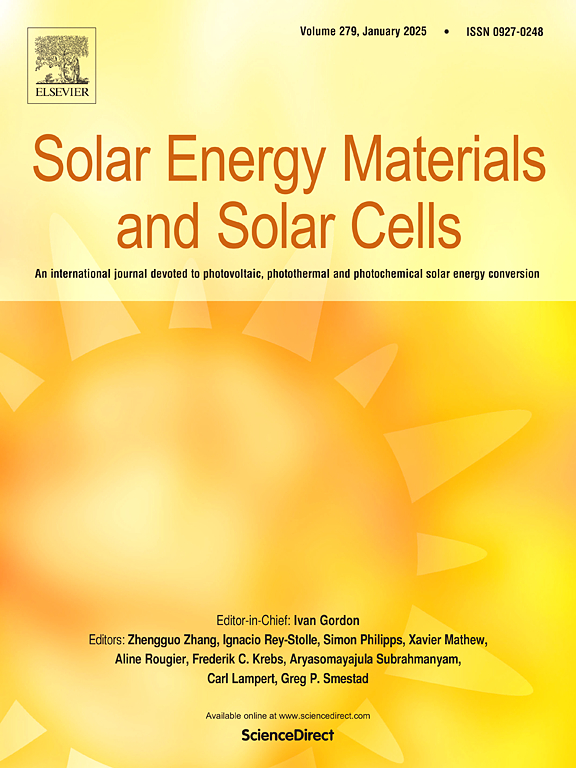Unveiling the degradation mechanisms in silicon heterojunction solar cells under accelerated damp-heat testing
IF 6.3
2区 材料科学
Q2 ENERGY & FUELS
引用次数: 0
Abstract
Silicon heterojunction (SHJ) solar cells have become one of the mainstream solar cells in the current photovoltaic market due to their high efficiency. Still, concerns about their long-term reliability are seen as a potential issue restricting further marketisation. In particular, the sensitivity of silicon heterojunction solar cells to high temperatures and moisture is a concern. Sodium (Na) in combination with humidity is widely considered one of the causes of degradation in silicon heterojunction solar cells. Yet, a comprehensive understanding of the mechanisms behind Na-induced decay remains lacking. This study will investigate humidity-induced degradation of industrial SHJ solar cells at elevated temperatures using various sodium-containing salts [sodium bicarbonate (NaHCO3), sodium chloride (NaCl), and sodium nitrate (NaNO3)] to improve our fundamental understanding of Na-induced degradation. We will show that SHJ solar cells exposed to NaHCO3 and NaCl show a significant reduction in efficiency, while solar cells exposed to NaNO3 show minimal degradation. Further analysis indicates that NaHCO3 may interact with the transparent conductive oxide (TCO) layer, leading to a reduction in surface passivation and a deterioration of the metal-TCO interface. NaCl primarily affects the Ag contact, resulting in a reduction of the adhesion of the screen-printed contact. Moreover, the TCO composition, particularly the oxygen content, influences its chemical tolerance. These results show that Na-related degradation is more complicated than initially thought. The chemistry is strongly influenced by the negative ions, as well as the composition of TCO and metal paste. These factors are determined by the bill of materials and the contaminants introduced during cell/module fabrication and operation of the SHJ module. The findings of this paper may lead to the development of new accelerated testing protocols for SHJ technology to ascertain long-term reliability in the field.
揭示硅异质结太阳能电池在加速湿热测试下的降解机制
硅异质结(SHJ)太阳能电池以其高效率成为当前光伏市场的主流太阳能电池之一。尽管如此,对它们长期可靠性的担忧被视为限制进一步市场化的潜在问题。特别是,硅异质结太阳能电池对高温和潮湿的敏感性是一个值得关注的问题。钠(Na)与湿度的结合被广泛认为是硅异质结太阳能电池退化的原因之一。然而,对na诱导衰变机制的全面理解仍然缺乏。本研究将使用不同的含钠盐[碳酸氢钠(NaHCO3)、氯化钠(NaCl)和硝酸钠(NaNO3)]研究高温下工业SHJ太阳能电池的湿度诱导降解,以提高我们对na诱导降解的基本认识。我们将证明,暴露在NaHCO3和NaCl下的SHJ太阳能电池效率显著降低,而暴露在NaNO3下的太阳能电池效率最低。进一步分析表明,NaHCO3可能与透明导电氧化物(TCO)层相互作用,导致表面钝化程度降低,金属-TCO界面恶化。NaCl主要影响银触点,导致丝网印刷触点的附着力降低。此外,TCO组成,特别是氧含量,影响其化学耐受性。这些结果表明,na相关的降解比最初想象的要复杂得多。化学性质受负离子以及TCO和金属浆料组成的强烈影响。这些因素是由材料清单和在电池/模块制造和SHJ模块运行期间引入的污染物决定的。本文的研究结果可能会导致SHJ技术新的加速测试方案的发展,以确定该领域的长期可靠性。
本文章由计算机程序翻译,如有差异,请以英文原文为准。
求助全文
约1分钟内获得全文
求助全文
来源期刊

Solar Energy Materials and Solar Cells
工程技术-材料科学:综合
CiteScore
12.60
自引率
11.60%
发文量
513
审稿时长
47 days
期刊介绍:
Solar Energy Materials & Solar Cells is intended as a vehicle for the dissemination of research results on materials science and technology related to photovoltaic, photothermal and photoelectrochemical solar energy conversion. Materials science is taken in the broadest possible sense and encompasses physics, chemistry, optics, materials fabrication and analysis for all types of materials.
 求助内容:
求助内容: 应助结果提醒方式:
应助结果提醒方式:


